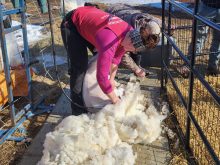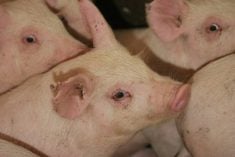BOW ISLAND, Alta. – After battling the wheat stem sawfly for more than 100 years, a new solid stem wheat could provide some respite for prairie farmers.
AC Lillian, a new variety with seed available this fall has yields and protein content similar to AC Barrie with a stem full of pith to starve out voracious stemfly larvae.
Finding a serviceable solid stem variety with good productivity is difficult, said Kevin Yaworsky, the Alberta representative for the seed company SeCan. In the past, producers who grew solid stem varieties paid a yield penalty.
Read Also

Charges laid after cattle theft
Saskatchewan RCMP lay two charges against a man after six cattle went missing.
“When you cross a solid stem variety and a hollow stem variety, only one in 64 of the offspring are solid stem,” he said during a crop tour of the John Crooyman seed farm near Bow Island in southern Alberta.
AC Lillian contains an inner core of pith with no nutritional value for the larvae found inside.
“The larvae is a little eating machine and as it eats its way down that pith, it can starve itself to death,” said insect specialist Fran Clarke of Agriculture Canada’s research centre in Swift Current, Sask.
The one disadvantage is weather. Pith develops best under warm, sunny conditions but not as well in cloudy weather.
Adult sawflies are tiny, black wasps with three yellow bands around their abdomens. They float among the developing stems when the plant tissue is soft from June to mid July, depending on weather conditions.
Inside story
The adult cuts a notch into the stem near the top and lays an egg.
The larvae are pale yellow with brown heads and feed inside the stem. They make an S shape when removed.
The larvae tunnel down the stem and pupate at the bottom of the plant. They then head upward and cut through the stem about two centimetres above the ground causing the plant to fall before harvest.
Each larva seals the cut end above itself, spins a cocoon in the stem and hibernates over the winter. It pupates and emerges as adult in early June from stubble fields.
The emerging fly can lay as many as 50 eggs to restart the cycle again.
There is no chemical control so management options include planting solid stem varieties, or sowing resistant plants like oats or other broadleaf crops in the rotation.
Another means of control is using a wasp parasitoid. The most effective is an orange coloured wasp that lays eggs in the stem of the plant. The wasp larvae then feed on the sawfly larvae.

















